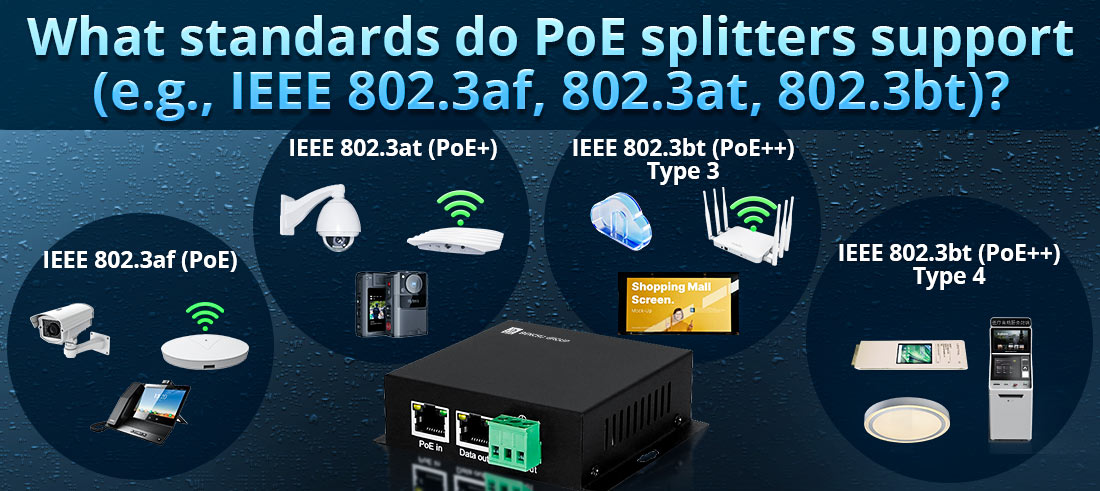
PoE splitters support different Power over Ethernet (PoE) standards depending on their power requirements and compatibility with network infrastructure. These standards determine how much power the splitter can receive and distribute to the connected non-PoE device.
1. IEEE 802.3af (PoE) – Up to 15.4W
Overview:
--- Introduced in 2003, IEEE 802.3af is the first official PoE standard.
--- Provides up to 15.4W per port, though only 12.95W is available after accounting for power loss in the cable.
--- Uses Category 5e (Cat5e) or higher Ethernet cables.
--- Supports 10/100/1000 Mbps (Gigabit Ethernet) networks.
PoE Splitter Compatibility:
--- Converts PoE input (48V) into lower voltages like 5V, 9V, or 12V.
Suitable for low-power devices, such as:
--- IP cameras
--- VoIP phones
--- Basic wireless access points (WAPs)
--- IoT sensors and embedded systems
2. IEEE 802.3at (PoE+) – Up to 30W
Overview:
--- Introduced in 2009, this is an upgraded version of 802.3af.
--- Provides up to 30W per port, with at least 25.5W available after cable loss.
--- Uses Cat5e or higher Ethernet cables.
--- Backward compatible with 802.3af, meaning PoE+ switches can power both PoE (15.4W) and PoE+ (30W) devices.
PoE Splitter Compatibility:
--- Converts PoE+ input (48V–57V) into 12V, 9V, or 5V DC outputs.
Suitable for moderate-power devices, such as:
--- High-definition IP cameras (PTZ cameras with motors)
--- Dual-band wireless access points
--- Video intercom systems
--- Some industrial controllers
3. IEEE 802.3bt (PoE++ / PoE++ Type 3 & Type 4) – Up to 60W / 100W
Overview:
--- Introduced in 2018, this is the latest and most powerful PoE standard.
Two categories:
--- Type 3: Provides up to 60W per port (51W after cable loss).
--- Type 4: Provides up to 100W per port (71W after cable loss).
Uses all four twisted pairs in an Ethernet cable for power transmission.
Requires Cat6 or higher cables for optimal performance.
PoE Splitter Compatibility:
--- Converts PoE++ input (48V–57V) into higher-wattage outputs (12V, 24V, or even 48V DC).
Suitable for high-power devices, such as:
--- 4K PTZ cameras with heaters
--- High-performance Wi-Fi 6 access points
--- Smart lighting and building automation systems
--- Digital signage displays
--- Mini PCs and industrial devices requiring more power
Comparison Table of PoE Standards for Splitters
| PoE Standard | Year | Max Power per Port | Usable Power | Devices Powered via Splitter |
| IEEE 802.3af (PoE) | 2003 | 15.4W | 12.95W | IP cameras, VoIP phones, basic access points, IoT devices |
| IEEE 802.3at (PoE+) | 2009 | 30W | 25.5W | PTZ cameras, dual-band APs, video intercoms |
| IEEE 802.3bt (PoE++) Type 3 | 2018 | 60W | 51W | High-power Wi-Fi 6 APs, large LED screens, industrial controllers |
| IEEE 802.3bt (PoE++) Type 4 | 2018 | 100W | 71W | 4K PTZ cameras with heaters, digital signage, high-power industrial devices |
Choosing the Right PoE Splitter
1. Check the power requirements of your non-PoE device (voltage and wattage).
2. Match the PoE standard of your splitter with your PoE switch or injector.
3. Ensure voltage compatibility (most splitters output 5V, 9V, 12V, or 24V).
4. Use high-quality Ethernet cables (Cat5e for PoE/PoE+, Cat6+ for PoE++).